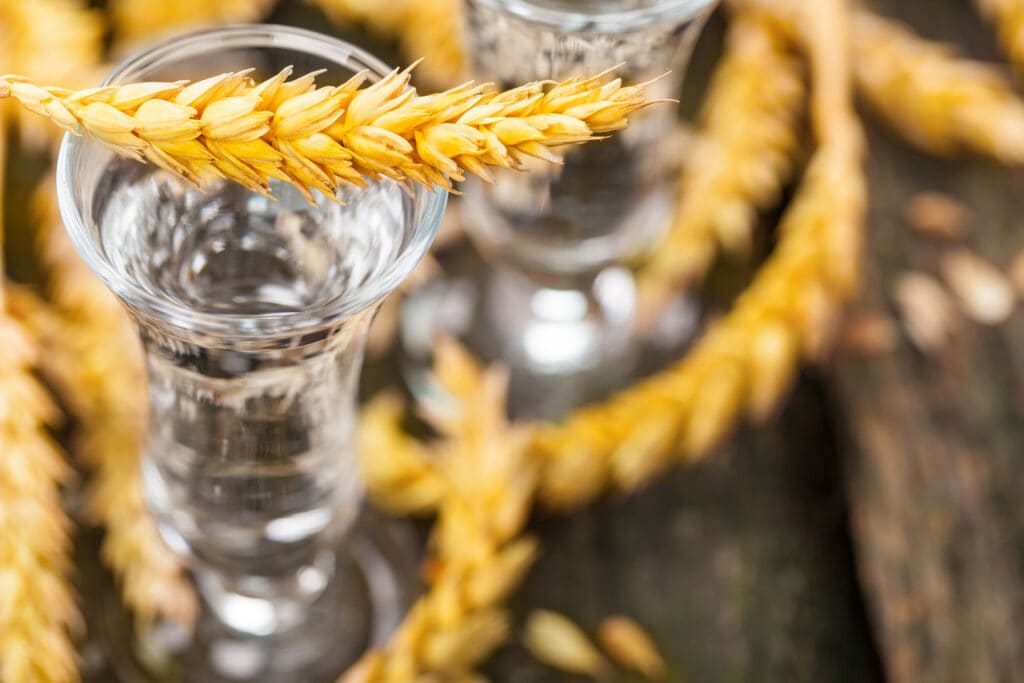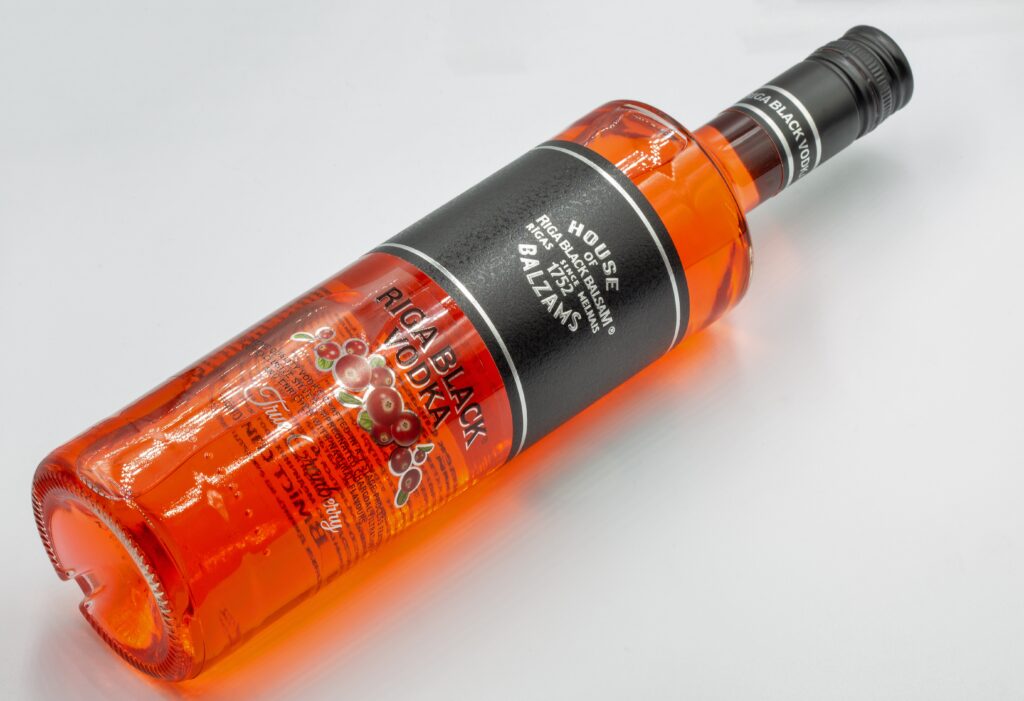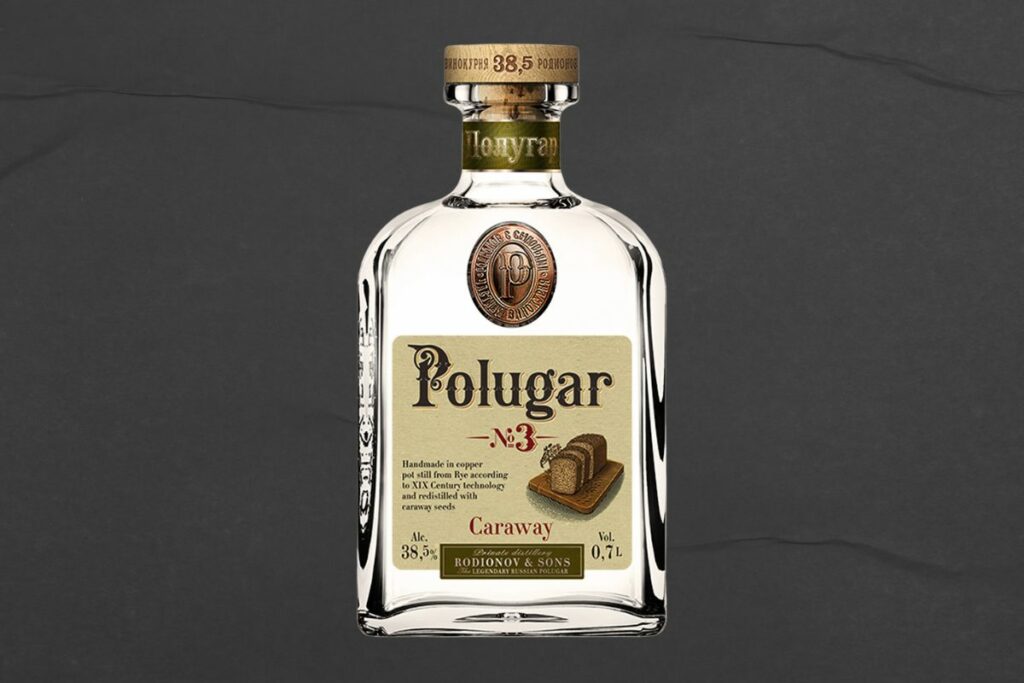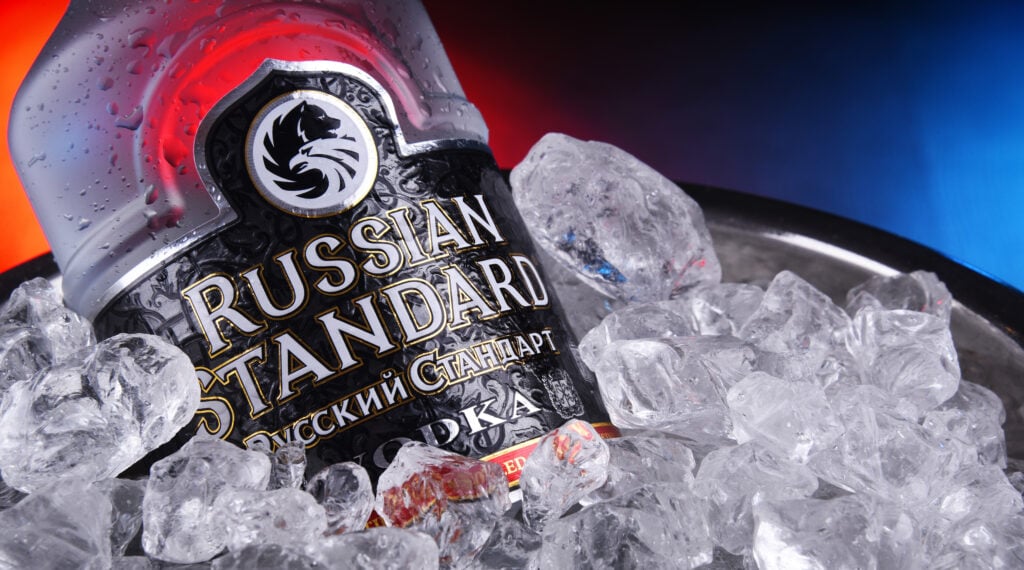14 Types Of Vodka
Ever been overwhelmed by the variety of vodka on a bartender’s shelf? Originating centuries ago, vodka is actually considered one of the purest spirits for its simple ingredients: water, wheat, rye, and barley. In this comprehensive guide, we’ll explore types of vodka – from grain to fruit-based – production methods and how they alter flavors. Let’s dive in!
Brief overview of what vodka is
Vodka is a distilled liquor that’s colorless and clear, with an alcoholic content usually between 40 to 55 percent. It consists primarily of water and ethanol, giving it a neutral spirit without any distinctive character, aroma, color or taste.
Vodka typically comes from grains such as wheat, corn or rye but you can also find vodka made with potatoes. The neutrality of its flavor serves well for cocktails where other ingredients contribute more pronounced tastes.
Over time, this once rough spirit has morphed into a refined beverage enjoyed all around the globe due to its versatility in mixology.
Importance of vodka in various cultures and cocktails
Vodka emerges as a celebrated spirit in many diverse cultures and forms the backbone of numerous enticing cocktails. In Russia, vodka holds an unshakeable position of national pride while engaging people through its essential role in traditional celebrations.
This versatile substance also finds notable mentions in cultural histories of various regions like Poland and Sweden, marking its significance beyond borders. Transcending from being just a beverage, vodka’s neutral flavor makes it immensely popular among cocktail lovers worldwide, showcasing its multifaceted importance across different facets of society.
History of Vodka
Dive into vodka’s fascinating journey from its obscure origins, involving meandering tales of Russian merchants and Polish distilleries, to becoming a celebrated spirit around the globe.
Discover how centuries-old traditions shaped modern vodka making and popularized this versatile liquor worldwide; there’s so much more to learn about this deceptively simple spirit.
Origin
Vodka traces its roots back to Eastern Europe or Russia, born in an environment where grain and potatoes were plentiful. The first noticeable footprint of vodka comes from Khylnovsk, Russia, as early as 1174 with the establishment of a distillery.
From Russia, vodka spread to neighboring Poland about two centuries later and then throughout Europe by the 16th century. It underwent various transformations during this journey – both in terms of production techniques and flavors, shaping it into the popular spirit known worldwide today.
This historical lineage underscores why vodka holds cultural significance within these regions and beyond.
Evolution
The evolution of vodka traces back to the Middle Ages, marking a journey that saw this distinct spirit become more refined and versatile over time. Initially consumed in Europe, vodka expanded its reach globally to emerge as a top-selling spirit worldwide.
The 18th century witnessed an increase in its strength, followed by the standardization of alcohol content in the following century. This transformation played a pivotal role in shaping various types and uses of this universal beverage we see today.
Vodka’s Global Popularity
Vodka’s global popularity can’t be overstated. This distilled beverage has surged to the top of many countries’ preferred spirits list, blending in seamlessly with many cultures worldwide.
In fact, the United States attributes a staggering 32 percent of its alcohol consumption to vodka alone! The unique flavors available are endless now, ranging from sweet and citrusy undertones brilliantly crafted cocktails that have helped fuel this growing demand further.
Above all else, vodka devotees are captivated by the refined yet smooth taste it offers without overpowering other ingredients when mixed right- whether it be for a celebration or a casual outing; it’s clear vodka has left its mark globally.
Basics of Vodka Production
To produce vodka, it typically requires high-starch or sugar-rich plants such as grains, molasses or potatoes. The chosen ingredient is fermented into alcohol and then distilled to achieve the desired potency.
This distillate undergoes a purification process, often through charcoal filtration, resulting in the smooth finish characteristic of premium vodka.
Ingredients
The making of vodka relies mainly on three primary components: water, ethanol or grain alcohol, and some optional flavorings. Originally, the crafters of this robust spirit used grains like rye and wheat, but later expanded their choice to include others such as sorghum.
Potatoes also found a position in vodka production with potato vodka gaining popularity. Alongside tradition, innovation introduced unique elements into the world of distillation. Corn became an innovative ingredient for crafting fine vodkas while fruits smoothly transitioned from mere flavoring items to base ingredients creating fruit-infused vodkas.
The use of sugar beet molasses unfolded another intriguing chapter in producing neutral spirits or what we know as distinctly smooth gluten-free vodkas.
Distillation Process
In the process of producing vodka, distillation holds a significant role. Producers heat and vaporize the liquid to kick start this fundamental phase. Different chemicals created in earlier stages get separated and collected for further use during distillation.
Not all vodkas undergo similar degrees of distillation; some go through just one or two rounds while others might see multiple runs in their production journey. The ultimate aim always remains to yield a distilled spirit as akin to pure ethanol as possible making it an intriguing element of spirit production using tools such as pot stills among other equipment involved.
Filtration and Purification
In the realm of vodka production, filtration stands as a crucial step. It effectively removes impurities from the distilled alcohol, allowing for heightened purity in the final product.
Depending on individual producer preferences, different types of filtration methods can be implemented which directly affects the taste and overall quality of vodka produced. Charcoal filtration is one such method used by producers to further refine and purify their spirits.
This pivotal stage sets vodka apart from other spirits; it’s responsible for creating its characteristic tasteless and neutral profile that allows it to seamlessly blend into cocktails or shine solo on the rocks!
Types of Vodka by Ingredient
Vodka is versatile, with variety stemming from its base ingredients like grain, the most common type including wheat and rye. Potato Vodka offers a creamier taste while corn vodka stands out for being gluten-free.
For an expressive burst of flavor – Fruit-Based vodkas are made. Additionally, unique options such as molasses or even milk create other intriguing types of vodka.
1. Grain Vodka

Grain vodka, made from grains such as barley, wheat, rye, and malted barley takes the lead as the most prevalent type of vodka. Wheat serves as a common base ingredient in renowned brands like Absolut and Svedka, giving this variety its distinctive smoothness.
Outshining others with its neutral flavor profile, this variant doesn’t sway away from delivering an authentic taste. Some versions even elevate the complex flavors by using mixed-grains while creating their blends.
With grain-based spirits gaining prominence for being gluten-free alternatives to traditional beverages – it’s safe to say that Grain Vodka is steering ahead, reshaping the course for future alcohol production.
2. Potato Vodka

Switching out wheat or rye grains, potato vodka boasts a distinctive flavor profile. Distilleries such as the Chase in Herefordshire create their spirit from three varieties of locally grown potatoes.
This type of vodka offers a heavy texture that sets it apart from other grain-based vodkas. If you’re seeking health-conscious spirits, consider potato vodka. It’s gluten-free and sugar-free with low carbs which also makes it an attractive option for drinkers with dietary restrictions or preferences.
Dense yet smooth, this non-grain vodka delivers unique flavors perfect for mixing cocktails or enjoying neat.
3. Corn Vodka

Producing corn vodka involves fermenting sugars that come directly from the sweet kernels of corn. The process results in a distilled spirit with a unique, full-bodied and soft texture that sets it apart.
With its delightful sweetness and subtle buttery quality, corn vodka is preferred by many for sipping neat or mixing into cocktails. Among the array of brands offering grain-based vodkas, popular names such as Tito’s Handmade Vodka, Smirnoff, Deep Eddy, and Sourced & Certified 1941 spotlight their versions of this corn-derived spirit to satisfy diverse taste preferences among vodka enthusiasts.
4. Fruit-Based Vodka

Fruit-Based Vodka takes vodka to another flavorful dimension. Unlike other vodkas made primarily from grains, potatoes or corn, fruit-based varieties use fresh fruits such as apples, peaches, and even grapes as the primary ingredient in production.
This type of vodka boasts a natural sweetness and richness that sets it apart on the palate.
In some cases, berries like raspberries and blackberries may be harnessed to give this vodka an appealing color besides enhancing its taste profile. Some craft distilleries have ventured into exotic domains by infusing their drinks with flavors like mango or pineapple for a tropical twist on tradition.
Regardless of what variations these fruity libations come in though, all aim for that same clear end product universally associated with top-notch quality in vodkas worldwide.
5. Other Ingredients

Vodka boasts a deep and vibrant culture of vivid flavors contributed by unique base ingredients. Many global vodka brands go beyond the traditional grains, potatoes, corn or fruits.
Some explore intriguing options such as berries, peppercorns and caraway for that distinct taste. Lemon peel or buffalo grass is another addition often seen in some exclusive vodka blends, translating to an interesting mouthfeel for consumers.
These distinctive ingredients undeniably create an exotic allure; they redefine the conventional notion of what composes vodka and make each bottle a whole new experience to discover!
Types of Vodka by Region
Exploring the world of vodka by region, we delve into Russian Vodkas known for their smoothness and classic taste, Polish vodkas distinguished by their purity, American vodkas that often bring unique twists to traditional production methods.
In Scandinavia, you’ll find premium brands with a distinct focus on quality ingredients. We will also highlight emerging regions revolutionizing the vodka market with new techniques and flavors.
6. Russian Vodka:Characteristics and popular brands

Russian vodka stands out for its smooth, clean taste. This distinctive profile owes to ethyl alcohol and water used in creating it which is fermented from grains such as rye and wheat or alternatives like potatoes or sugar beet molasses.
Traditional distillation methods further enhance the quality. Renowned brands echoing these characteristics are Russian Standard, Beluga Noble, Husky Vodka, Jewel of Russia among others.
Aside from being served straight in a chilled state, this spirit also becomes an essential base for beloved cocktails including Moscow Mule or White Russian. Representing a significant part of the country’s culture and history with its rich tradition, Russian vodka truly maintains a special place in sports production globally.
7. Polish Vodka:Characteristics and popular brands

Polish vodka, or “wódka”, carries a rich history back to the Middle Ages. This drink was initially used for medicinal purposes but soon became a beloved traditional beverage representing Polish culture.
Known for its premium quality and exceptional flavor profile, Polish vodka stands amongst some of the world’s best spirits.
Beloved brands like Belvedere, Wyborowa, and Chopin resonate with vodka lovers worldwide due to their smooth taste resulting from careful distillation processes. Other prominent names like Luksusowa, Zubrowka, Pan Tadeusz,Ostoya,and Orkisz continue enriching the liquor market with innovative blends that honor Poland’s distilling traditions.
It is these attributes that attribute to making polish Vodka popular among enthusiasts in an already teeming global alcoholic beverages industry.
8. American Vodka:Characteristics and popular brands

Corn takes center stage as a primary ingredient in American vodka, hailed for its sweet and smooth characteristics. Brands like Tito’s Handmade Vodka and Deep Eddy are at the forefront of this trend.
The market also offers diversity with vodkas distilled from rye, wheat, barley or rice. Famed brands such as Hangar One, Material and Spring 44 embody traditional techniques infused with modern flair to create distinctive flavors that resonate on international platforms.
The rise of these regional styles is rapidly propelling American vodka into global limelight. With innovation continuously stirring up the industry, enthusiasts can expect to encounter further exciting interpretations of this versatile spirit by American distilleries.
9. Scandinavian Vodka:Characteristics and popular brands

Scandinavian vodka displays a unique purity and smoothness, hallmarks of its traditional production methods. Sweden gives us prestigious brands like Absolut Vodka, renowned globally for premium quality.
Another notable brand is Spirit of Hven Organic Vodka, praised for its organic ingredients and sustainable distillation process. Finland contributes to the global market with Finlandia Vodka, offering an authentic taste that sets it apart from others in the industry.
These Nordic spirits reflect cultural significance within their regions while earning recognition worldwide for their clean flavor profile perfect for creating popular cocktails or savoring on their own.
The refined characteristics of Scandinavian vodka draw consumers seeking a crisp texture coupled with an unadulterated taste typical of premium vodkas.
10. Other Regions:Emerging vodka-producing regions

Countries like India, China and South Africa are stepping into the vodka production game. Attracting consumers with locally-sourced ingredients and unique distillation techniques, these markets stir diversity into the global industry landscape.
As fresh players in this field, they infuse novel flavors and regional twists that give their products a distinct identity. The tart Rye Vodka of Canada sketches an exciting profile whereas Australia’s adventurous innovators use native grains for a hint of familiar taste penetrating through each sip.
In parallel to traditional countries like Russia and Poland, these emerging trends signal excitement within the diversifying world of vodka amidst growing markets worldwide.
Flavored Vodkas
This section delves into the enticing world of flavored vodkas, exploring commonly used fruit and spice flavors as well as unique combinations that elevate this spirit to a whole new level.
11. Fruit Flavors
Diverse and tantalizing fruit flavors rule the realm of flavored vodkas. Cherry, blueberry, raspberry, lime, coconut, apple – these are some crowd favorites in fruit-infused vodka production.
Freshness bursts from every sip with citrus-infused vodkas showcasing lemon or orange undertones while tropical fruit-flavored ones offer an exotic journey on your palate with distinctive grape or pear notes.
Integral to the process is sugar which enhances these appealing natural flavors further and provides a sweet carrier for their tastes. From harsh winter days yearning for summer’s warmth expressed through strawberry tones to relaxing poolside parties needing that splash of peachy sweetness; there is a fruity vodka to enhance any moment.
12. Spice Flavors
Spice flavored vodkas bring both complexity and an adventurous twist to the wide array of vodka varieties. They infuse their spirits with natural spices such as jalapeno, habanero, and cayenne for a bold kick in every sip.
This mix gives cocktail enthusiasts a great choice when they want some heat in their drinks. Touches of honeyinfused alcohol help balance out the spice and add enticing sweetness to these unique beverages.
From pepper infused vodkas to habaneroinfused liquors, there is definitely something special about these spicy cocktails that make them unforgettable!
13. Unique Flavors
Vodka flavors extend beyond the common fruit and spice options, venturing into unexpected territories. Brands like Oddka push the boundaries with quirky vodka varieties such as salty caramel popcorn, apple pie, wasabi, and fresh cut grass.
Even breakfast finds its representation in unique vodka offerings like bacon-flavored booze. Dessert lovers enjoy unconventional selections like frosting flavored vodkas while gourmands delight in distinctive choices hinting at smoked salmon or black truffle.
These peculiar vodka options may seem bold but have deep roots dating back to Poland’s historic use of herbs and grasses for flavor infusion in centuries past. Today’s trend towards exotic flavors continues to enliven the industry with offbeat selections tailor-made for adventurous palates seeking unusual yet exciting taste experiences.
14. DIY Flavored Vodka
Diving into the realm of DIY flavored vodka can be an exciting experiment. Here are some steps to get you started:
- Select your base vodka: The choice of vodka plays a crucial role in the final taste. You can opt for a high-quality, neutral spirit that won’t interfere with your flavors.
- Decide on your flavorings: From vanilla and citrus to surprising additions like jalapeño or rosemary, this is where you customize your drink.
- Infuse the vodka: Add your chosen ingredients to the vodka and let it sit. Be patient; this process can take anywhere from a few days up to a week.
- Strain and bottle: After infusion, strain out solids and transfer your newly created flavored vodka into a clean bottle.
- Test different combinations together: Experiment by mixing various infused vodkas for unique cocktails.
- Enjoy personalized cocktails: With your homemade infused spirits, indulge in your very own exclusive cocktail recipes.
- Keep experimenting: The beauty of DIY mixology lies in its endless possibilities. Always stay open to new flavor combinations!
Vodka in Cocktails
Explore the versatile nature of vodka in cocktails, with a focus on classic mixes such as the bloody Mary and martini, alongside contemporary concoctions that highlight vodka’s ability to pair with a plethora of flavors.
Classic Vodka Cocktails
Classic vodka cocktails have earned their place in the world of mixology due to their timeless appeal and versatility. The Bloody Mary, a vibrant blend of tomato juice, spices, and vodka, garnished with celery for added flair is a brunch favorite worldwide.
Illuminate your evening party with Screwdrivers — an effortless blend of orange juice and smooth vodka. The crisp flavor harmony between ginger beer, lime juice, and vodka make the Moscow Mule a refreshing choice at any festive gathering.
Not just these classics but consider beverages like the Vodka Gimlet; traditionally made with gin but now popularly enjoyed with vodka too! Advance towards modern classics such as Espresso Martini or Grapefruit Cooler – both demonstrating how well vodka harmonizes even with unconventional cocktail ingredients.
From famous tropical Pineapple Martinis to sophisticated drinks like Valentino and Dukes’ Martini – high-quality vodka paves its way into various delectable blends catering diverse taste buds across the globe!
Modern Mixes
In recent years, innovative vodka cocktails have captivated the mixology scene. The Espresso Martini explodes with a caffeine kick and smooth vodka undertones. Another modern mix is the French Martini, a fusion of vodka, pineapple juice and Chambord that delights with fruity notes and hints of raspberry tones on the palate.
Cocktail enthusiasts often experiment with various ingredients to create unique drinks at home as well—over 30 easy-to-make recipes are available for budding mixologists! These modern mixes showcase the versatility of vodka in cocktail craft, from refreshing citrus sips to strong coffee-infused concoctions.
Each recipe adds its own twist while highlighting vodka’s distinct qualities in today’s vibrant cocktail culture.
How to Choose a Vodka
When choosing a vodka, it’s essential to consider the price point versus its quality. Also, think about the occasion – you might opt for a top-shelf bottle for special events and a mid-range one for casual parties.
Pay attention to your personal preference too; are you after smoothness or more characterful nuances? This section will guide you in making an informed decision that suits your taste as well as your budget.
Price vs Quality
Choosing the right vodka often boils down to price versus quality. A common myth is that an expensive label guarantees a superior spirit, this is not always accurate. Prices can range significantly from $10 to over $100 per bottle, and it’s important to consider whether it truly matches your taste preferences for vodka rather than making decisions based solely on cost.
Good quality vodkas don’t typically offer clear advantages in terms of flavor or smoothness when compared with affordable vodka options, contradicting the assumption about the link between price and spirit quality.
Factors like brand popularity also influence vodka prices prominently but may not be indicative of the liquid within! So, spend wisely; high-quality doesn’t have to equate high-price-tag when selecting your perfect pour.
Occasion
Choosing the right vodka for your occasion elevates the event to a whole new level. Be it a casual get-together, or a formal dinner, the type of vodka sets the tone. Magnum Grey Goose is a popular choice that always impresses during special occasions because of its smooth flavor and prestige status.
For more informal settings, consider cocktail vodkas whose types depend on their ingredients and setting. Cocktail parties might call for flavorsome vodkas like Absolut Citron or Stolichnaya Vanilla to provide an interesting twist to classic mixtures.
Meanwhile, weight-conscious individuals often turn towards vodka due to its low calorie content, making it a solid selection for wellness-centered events such as yoga retreats or healthy lifestyle meetups.
The process behind each bottle – whether distilled multiple times or bearing unique infusions – contributes significantly to its appeal in varying situations too.
Personal Preference
Choosing vodka that suits your personal preference can be a straightforward process once you understand what appeals to your taste buds. You might opt for higher quality, more distilled versions if complex flavors intrigue you.
On the other hand, some people gravitate towards vodka because of its low calorie and gluten-free nature, making it an ideal match for health-conscious drinkers. Vodka’s versatility makes it shine in mixed drinks and cocktails; the way it harmonizes with various flavors could guide your choice too.
Your ultimate selection will often come down to finding balance between flavor blending, caloric content based on serving size, and an appreciation for the distillation process behind each bottle of this popular alcoholic beverage.
Conclusion
Vodka’s vast versatility rivals its fascinating history. With grounds in tradition and an evolving role in the modern world, it continues to be a spirit of choice for many. Whether you’re exploring flavors or regions, vodka offers you an exciting journey.
Dive into this diverse spirit and discover your ideal vodka experience today!






